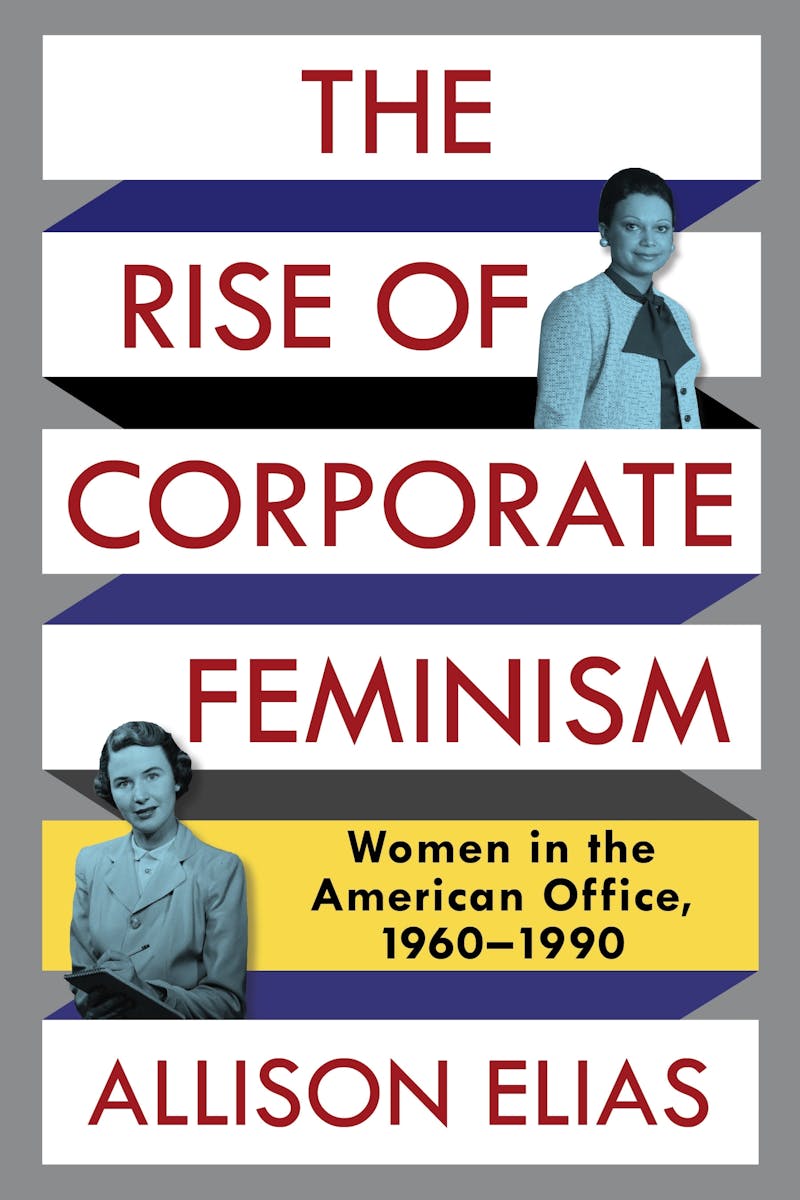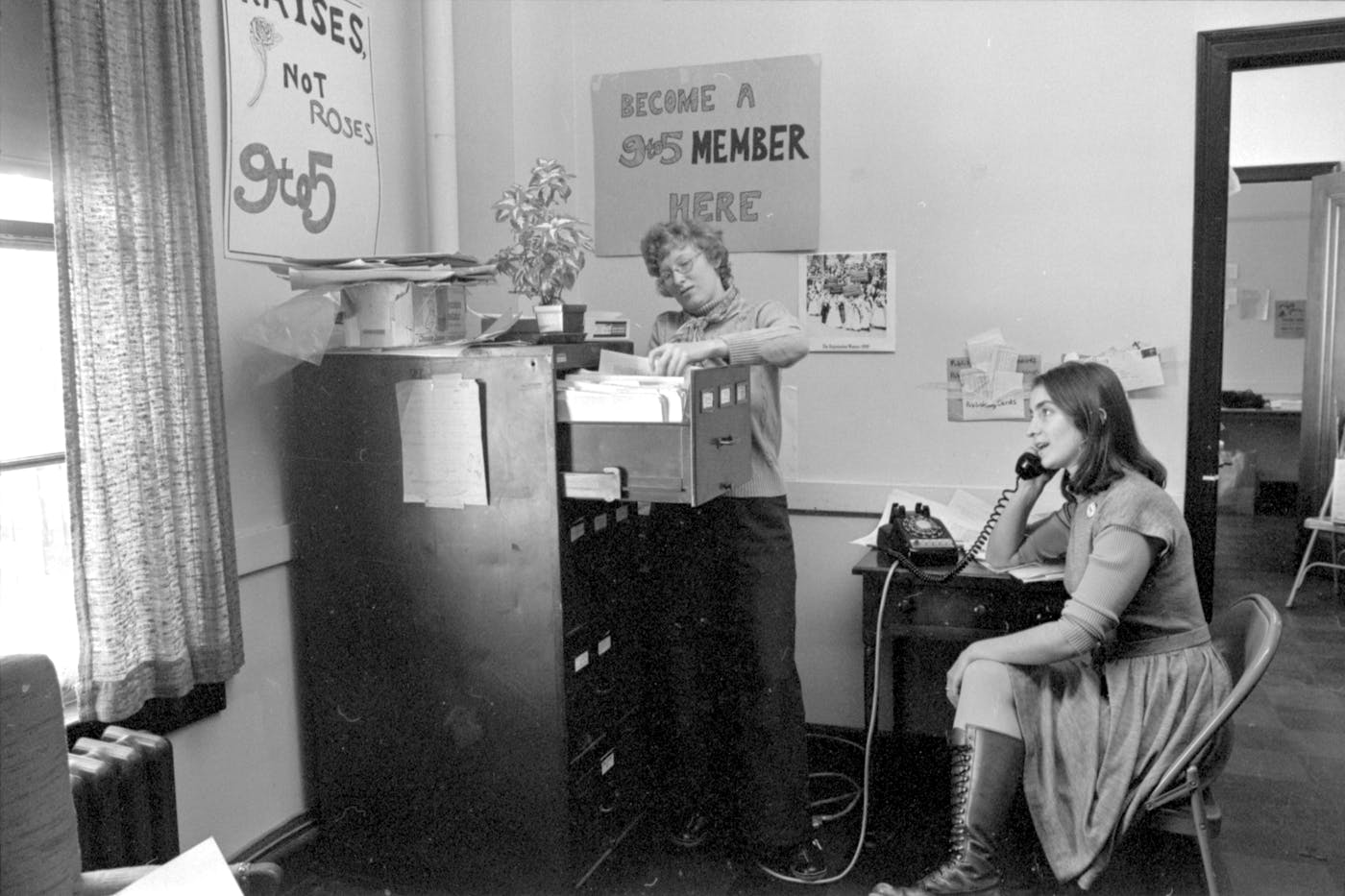In 1909, a horologist and sailing enthusiast named William Gibbs died at the Edgewood Yacht Club in Cranston, Rhode Island, after falling from the mast of his boat. The accident widowed his wife, Katharine, then 46, leaving her to support their two sons as well as an unmarried sister. But her circumstances did not remain straitened for long. With startup capital funded by the sale of her jewelry and help from family friends, in 1911 Katharine bought the Providence School for Secretaries, soon changing the name to the Katharine Gibbs School. Equal parts finishing school and vocational academy, the venture was so successful that, by 1918, Gibbs had satellite campuses in Boston and New York, and, by 1930, she was living on Park Avenue with her family and three full-time servants, pulling in what would be the equivalent of $1.4 million a year today.
The Gibbs School did much more than make its founder fabulously wealthy: It helped establish the image of the secretary as an unfailingly professional, naturally demure, and resolutely feminine helpmate. “Katie Gibbs girls,” as they eventually came to be known, were fined for chewing gum in class. They prepared coffee in silver-plated urns, and from the 1940s to the mid-1960s were required to wear white gloves. Lucy Graves Mayo, a Gibbs instructor and author of the 1965 advice manual You Can Be an Executive Secretary, preached that achievement in the field required recognizing that the “boss is KING.”
This was the state of affairs second-wave feminists deplored when they threw stenography pads into the so-called Freedom Trash Can during protests at the 1968 Miss America pageant in Atlantic City. So entwined was the Gibbs School with the popular conception of secretarial labor as stereotypical women’s work that, when the National Organization for Women marched through Manhattan during the 1970 Women’s Strike for Equality, the school was one of the few stops it made. NOW members forced their way into the lobby and squared up to president Alan L. Baker, whom they reproached for perpetuating occupational segregation—and for referring to his grown women students as “girls.”

In the decades that followed, a new model for women’s work defined itself against everything the secretary signified. The aspiration of “corporate feminism” was to ascend to the top of the executive ladder, to be the boss instead of doing his filing—and, supposedly, to improve the lot of all working women with your own personal accomplishments. According to this logic, individual success is valorized at the expense of collective rights, and any choice a woman makes is, by virtue of her gender alone, deemed “empowering.” Corporate feminism’s most recognizable (and controversial) figurehead has been former Meta chief operating officer Sheryl Sandberg, whose 2013 paean to the radical power of corporate gamesmanship, Lean In, launched a thousand imitators—and at least as many magazine pieces. (Though also notable is Nasty Gal founder Sophia Amoruso, who popularized the term “girlboss” shortly before mismanaging her fast fashion empire into Chapter 11 bankruptcy.)
Beyond publicity, the actual gains of CEO-style feminism have been narrow. While women’s workforce participation increased by nearly a quarter between 1950 and 2010, clerical work continued to be the most common job for women. Yet corporate feminism has spread beyond the C-suite, to become perhaps the most culturally dominant form of feminism, even if its primacy is now on the wane. For years, female executives occupied a rarefied place in the media firmament, posing for glossy magazine profiles with blowouts and baby bumps. They proselytized the hustle on the Today show, in the captions of artful Instagram posts, and especially from the makeshift stages of convention halls. In 2016, Bloomberg reported that there had been so many women’s empowerment and networking events the previous fall that it would have been feasible to attend one almost every day—whether Tina Brown’s Women in the World Summit or newscaster Mika Brzezinski’s Know Your Value conference.
Communication scholar Allison Elias points out in her new book that the triumph of corporate feminism was far from inevitable, but the result of struggle within the feminist movement and the changing face of American capitalism. Starting in the 1960s, her book traces two competing visions for women’s working lives. One path forward lay through pulling together and improving the work that women already did—with activist organizations like 9to5 agitating for better conditions at the office. Another path meant leaving that work behind, and aiming for more powerful, better-paid positions—a feminism focused on breaking the class ceiling. If corporate feminism is now on the downswing from its 2010s heyday, then the unfinished project of 9to5 presents an increasingly appealing alternative.

Elias’s story begins far from the corner offices and TED talks of corporate feminism as we have come to know it. Instead it starts with the attempts of clerical workers to improve their lot. Some of the heroes of her book are the leaders of 9to5, which was co-founded by Karen Nussbaum and nine other secretaries in Boston in 1973. Nussbaum was a veteran of the Black Panther Support Committee, who began turning her attention to women’s issues after an alienating experience with the male-dominated culture of the Students for a Democratic Society. While working as a clerk-typist at Harvard, she set out to build an organization that would rally around “the immediate needs of office workers”—many of whom did not identify with the feminist movement, even if they were influenced by its ideas.
To set its agenda, 9to5 surveyed secretaries throughout Boston, collecting information about income, health insurance, and other benefits, as well as “job descriptions, job training, and the presence or absence of union campaigns.” To attract membership, the group produced a newsletter replete with anecdotes from fellow secretaries about enduring bad pay, disrespect, and boredom on the job; members distributed it during commuting hours at transit stops and outside the insurance firms where many clericals worked, deliberately dressing in sedate office wear rather than denim, which might betray their project’s radical hopes to hesitant recruits. Their first meeting, held in November 1973, attracted 50 women; by 1977, the group had chapters in 13 cities, 10,000 members, and an operating budget of $700,000.
But as 9to5 grew, it struggled with an internal contradiction. The group appealed to women whose concerns were primarily economic—they were seeking better pay and conditions for the work they were currently doing. But its membership also included women whose concerns were mainly professional—specifically, women who hoped to cross over from clerical work into management.
The first of 9to5’s industry-specific subcommittees, Women in Publishing, was largely made up of women in the latter category. WIP members tended to be college-educated, and while they supported the union activity of clerical workers at Boston-based publishing companies Allyn & Bacon and Beacon, their own platform was “focused on career development,” Elias writes. In the 1970s, women interested in careers in publishing had little choice but to begin in administrative roles, and many found—despite a few highly publicized success stories—that it was nearly impossible to move into editorial or managerial positions regardless of their job performance, while men with less experience quickly ascended the ranks. (In publishing, as in other industries, hyper-competence could perversely work against a secretary’s desire to switch career tracks, as it made her even more indispensable to her boss.)
WIP’s response to these conditions was largely procedural: Members filed complaints with the Office of Federal Contract Compliance Programs, the Massachusetts Commission Against Discrimination, and the Equal Employment Opportunity Commission, alleging that their employers were failing to comply with the affirmative action requirements established by President Lyndon Johnson in the mid-1960s. When a group of women at Houghton Mifflin saw that their charges of sex and wage discrimination would not be addressed by these agencies in a timely fashion, they filed a class-action lawsuit in 1975 and became known as the “Houghton Mifflin Five.”
WIP’s pressure campaign achieved some modest wins. It demanded, for instance, that companies should post managerial and editorial job opportunities internally, so that clerical workers would have the chance to apply for higher-level positions. Members believed they only needed equality of opportunity to succeed. By 1976, they’d convinced at least seven Boston-area publishing houses to change their job posting systems. But the effects were minimal. Companies invested in consultants and emergent HR departments that would help them meet their affirmative action burdens on the cheap by hiring externally and manipulating job titles for reporting purposes, rather than by helping clerical workers’ transition onto the editorial or managerial ladder (or by, say, raising their salaries).
The goals of groups like WIP were reasonable: Women should be informed of job openings at their own companies and considered viable candidates for positions outside their classification on the basis of their potential, as men so often are. Yet their strategies “unwittingly fractured the feminist agenda at work,” separating the women who would rise up the ranks and receive better treatment and compensation as a result from the majority who would continue in low-level positions.
This split only became more dramatic over the 1980s and 1990s, as clerical work became more precarious. With the rise of computing, the secretarial profession became nearly as vulnerable to de-skilling as factory work. The widespread adoption of video display terminals led to a steep increase in workplace injury, particularly eye strain and carpal tunnel syndrome. The fact that secretaries across the country had quickly learned to master a new form of technology did not increase the profession’s esteem. Rather, automation led to the offshoring of clerical labor to Mexico, the Caribbean, and Asia, and enabled companies to transform many full-time jobs into part-time, temporary positions.
In response to these changes, 9to5 created a nationwide clerical union, District 925 of the Service Employees International Union (SEIU), in 1981. Yet as the profession changed, the organization “struggled to find a unifying agenda and identity,” and it faced the headwinds of the anti-union Reagan administration. Elias writes that the union was “decertified or lost elections in all but three private-sector organizations during the 1980s.” Some companies, like Equitable Life Insurance in Syracuse, New York, simply closed up shop when District 925 won an election there. SEIU and 9to5’s experiment was far from an outright failure, but it proved unable to raise union density among U.S. clerical workers to even 10 percent. It also failed to slow the spread of a workplace feminism centered on professionalization, one that ascribed the low status of secretaries to their inability to “make it” in a more prestigious field.
At times, Elias’s book may give the impression that corporate feminism became the dominant form of workplace feminism almost by accident: The splintering of the second wave and subsequent backlash to the women’s movement coincided with the neoliberal turn in American governance, and corporate feminism outlasted more collectively minded alternatives because it was most compatible with market logic. But a closer look at the period Elias covers—when a new media ecosystem marketing to professionally ambitious women thrived—shows its success was more than a historical fluke. Corporate feminism was a coherent ideology in its own right, one many women flocked to out of enthusiasm rather than necessity.
Working Woman magazine, launched in November 1976, was “the first magazine explicitly for wage-earning women,” Elias writes. Its debut issue, titled Making It!, did not disguise its relationship to the feminist movement: In a letter to readers, editor Beatrice Buckler positions the magazines as a kind of Ms. for professionals, heralding a “social revolution” with “new roles for single women,” and “new relationships between mothers and children, men and women.” The rest of the issue is full of practical and cosmetic advice, devoted to concerns like the use of injectable silicone to treat acne scars and balancing a career with romance. One of its more substantial pieces, “OFFICE POLITICS: RUNNING A CLEAN CAMPAIGN,” cautions working women that they must temper their “domestic set of values (honesty, openness, and trust)” with “business ethics (competition, aggressiveness, productivity, winning).” Journalist Victoria Pellegrino urges an every-woman-for-herself individualism: “There are few rescue squads in business, fewer knights in shining armor,” she writes. “You and nobody else have to be in charge of your career.” This rhetoric was very different from the strategies promoted by second-wave feminists or more pragmatic groups like 9to5, and it attracted a significant audience: By 1980, Working Woman was the fastest-growing magazine in America.
The next decade brought a new and ambitious competitor. Savvy billed itself as “The Magazine for Executive Women,” and it, too, recognized its debt to feminism. The first issue included an impassioned editorial in favor of the Equal Rights Amendment by Ms. co-founder Jane O’Reilly. Its lineup contained many major elements of full-blown popular corporate feminism today: a focus on finding mentors, inspirational success stories, and having it all. Perhaps the issue’s most representative article is Jane Wilson’s “NETWORKS,” which predicts that women’s professional networks will “become the feminist phenomenon of the 1980’s,” channeling the energies once captured by consciousness-raising groups and other more radical collectives. She chastises the previous decade’s period of “high feminism” for its “negative” focus on “the pitiable condition of women in sexist society” and presents networking as a “cheap, bootstrapping method of taking direct action on one’s own behalf.” Bra-burners beware, Wilson warns: “Although networking grew directly out of the women’s movement, its rationale is sharply different in many respects.… The first requirement for network membership is more or less naked self-interest.”
Alongside these publications rose a raft of how-to books advising women on the best ways to rise through the professional ranks with nothing but their own ingenuity. Among them was Betty Lehan Harragan’s Games Mother Never Taught You: Corporate Gamesmanship for Women, published in 1977. Harragan, a longtime member of NOW, outlined the forces arrayed against women in the office: not just their social ostracism from a boy’s-club culture, but outright discrimination and sexual harassment, too. Rather than advocating to tear the whole rotten system down, however, she provided a blueprint to exploiting it for your own benefit. Harragan argues that corporate structures take their cue from military hierarchy, and that the “everyday operations” of private industry resemble team sports—two idioms women must master if they want to compete with men at work. And as for unwanted sexual overtures, well, a woman’s “continued success may be her expertise in blocking these passes while maintaining a pleasant, friendly, unsullied work relationship with the man (men) involved.” This grin-and-bear-it ethos is justified by the idea that until a woman reaches the C-suite, she has no chance of changing company culture. As such, Harragan is disdainful of working women who set their sights any lower than CEO—and secretaries come in for special censure. “A secretarial job classification is the supreme dead-end,” she writes. “Obviously, a woman with ambitions must blast out of this job classification before she can become a team candidate.”
Harragan’s book became a minor sensation: It was assigned in undergraduate college courses and at business schools; adapted into a CBS-TV movie in 1982 (co-starring future Law & Order stalwart Sam Waterston); and, as the cover of the 1989 edition boasted, it sold over a million copies. But it was simply the most successful of a glut of professional self-help aimed at women, a genre less notable for producing blockbusters than for its sheer volume. In a review in these pages in 1986, Barbara Ehrenreich waded through a pile of books with titles like The Right Moves: Succeeding in a Man’s World Without a Harvard MBA and Feminine Leadership: Or How to Succeed in Business Without Being One of the Boys, each offering similar advice with a twist here and there. Since the 1970s, Ehrenreich observes, “scores” of such guides had transformed the popular image of the “liberated woman” into “a tidy executive who carries an attaché case and is skilled in discussing market shares and leveraged buy-outs.”
The overwhelming majority of professional self-help, Ehrenreich proposes, pointed to a hollowness in the whole pursuit. “Perhaps the most striking thing about the literature for and about the corporate woman,” she writes, “is how little it has to say about the purposes, other than personal advancement, of the corporate ‘game.’” Corporate feminism, with its relentless focus on success, lacked perspective on what might make labor meaningful, or indeed any different from the full-time domestic drudgery that many working women had only just left behind. The dream nurtured by the women of the Houghton Mifflin Five a decade earlier, of receiving better wages for creative work, had been reduced to the single-minded pursuit of money and power for its own sake.
But there was a burgeoning genre of advice, marketed to both men and women, designed to fix this problem. Career self-help in the ’80s increasingly trumpeted the notion that a career is a calling and that work is an extension of your true self. One notable example was Richard Nelson Bolles’s What Color Is Your Parachute?, a spiritual guide to job selection that Bolles, an out-of-work priest, originally distributed to other unemployed clergy as a kind of proto-zine in 1970. He revised it for the general public in the mid ’70s, after which it became a bestseller for decades. The book and others like it, the sociologist Micki McGee has written, “channeled the counterculture value of self-fulfillment back into the productive spheres—back into the workplace.” Bolles laments that “the world is currently filled with workers whose weeklong cry is, ‘When is the weekend going to be here?’” Rather than reflecting a problem with the way we organize work, he contends that such dissatisfied employees need only to discover “what they uniquely have to offer to the world.”
By the time Sheryl Sandberg’s Lean In became a sensation in 2013, there was little sign of the angst Ehrenreich had detected three decades earlier. Indeed, Sandberg’s book takes for granted that a woman’s success is a moral and political good in itself, even a revolutionary one. Lean In is a manifesto of individualism that proceeds from the premise that “the shift to a more equal world will happen person by person”—and only once those persons adjust their behavior to better suit the status quo. Sandberg pays lip service to the “real obstacles in the professional world” that women encounter, like discrimination, harassment, insufficient policies around parental leave and childcare. But the true concern of her book is the way “women are hindered by barriers that exist within ourselves,” namely a lack of self-confidence, assertiveness, and ambition, internal obstacles that she inaccurately claims have gone under-explored. Despite dressing the book up in cutting-edge social science findings, Elias notes, Sandberg “was offering recommendations similar to those that had imbued the advice literature of the 1970s and 1980s.”
It resonated: Five years after its publication, Lean In had sold 4.2 million copies worldwide and was continuing to move an additional 12,500 copies a month. Where once the consciousness-raising group had given way to the network, now there were tens of thousands of Lean In “circles” where women “met regularly to discuss and implement Sandberg’s guidance,” according to The Washington Post. The vogue that Lean In sparked for women’s professional development became much bigger than the book itself, spawning a lucrative industry of workshops and conferences, and elevating figures like Glossier’s Emily Weiss, the Wing’s Audrey Gelman, and Moon Juice’s Amanda Chantal Bacon as role models and thinkfluencers. If the economic fruits of corporate feminism failed to trickle down as prophesied, its moral code certainly did: its encouragement of would-be entrepreneurs to harness their social media profiles as marketing tools, work around the clock, and treat self-interestedness as a virtue. Even women who didn’t actually aspire to executive positions began to fret about their personal brands, adopting corporate feminism as more of a lifestyle than a strategy for career advancement. Some 40 years on from the founding of Working Woman, the movement’s message was simple, confident, and extremely popular.
Until it wasn’t. While corporate feminism has had astute critics from the very beginning, it’s only in the last few years that its failures have been widely noted. The fame and personal wealth of a handful of female CEOs did not create a flood of opportunities for the women below them on the corporate ladder, nor did it necessarily lead to more hospitable environments for women in the companies they presided over: Nasty Gal was sued for illegally terminating pregnant employees; female executives at luggage retailer Away were accused of publicly berating their workers and demanding uncompensated overtime; and both Gelman and Bacon, among others, were called out by Black former employees for fostering racism in the workplace while catering primarily to an elite white clientele. That’s not to mention Sandberg herself, whose continued work at Meta is notable not only for the lack of good it has done women in the abstract, but for its very tangible harms, such as exposing user data to the political consulting firm Cambridge Analytica in 2016 and knowingly contributing to eating disorders among teenage girls on Instagram.
It’s probably not a coincidence that the bloom is off corporate feminism’s rose at a moment when the Covid-19 pandemic has underscored the precarity of many women’s economic positions; between job losses and increased caregiving demands, millions have been pushed out of the workforce over the last three years. The flood of bad press about individual She-E-Os has been accompanied by a series of unflattering pop culture portrayals, from Amanda Seyfried’s Emmy-winning turn as disgraced Theranos founder Elizabeth Holmes, to Leigh Stein’s scathing portrayal of a wellness startup in the 2020 novel Self Care, to the emotionally stunted young investment bankers of HBO’s Industry. In the last three years alone, outlets including Forbes, Wired, The Atlantic, Fast Company, Jezebel, Adweek, and The Cut have declared the end of the girlboss era. And on social media, particularly among younger women, the tenets of corporate feminism now persist mostly as a meme: “Gaslight Gatekeep Girlboss.”
The movement’s innovations were always somewhat limited. Katharine Gibbs, the twentieth-century doyenne of secretarial education, was after all what we might today call a “female founder.” And while her vision of success was very different from, say, Sheryl Sandberg’s, the advice she gave her students was similar in substance to the lessons peddled by so many corporate feminists who followed in her wake: Work hard, don’t rock the boat, and never forget to smile.
As the ashes of the girlboss are scattered to the winds, The Rise of Corporate Feminism reminds us that the truly novel moments in the history of feminism at the office concern the much trickier efforts of women to improve the conditions of their jobs together—and how those efforts changed them. In “WOMEN WORKERS AND THE YALE STRIKE,” her 1985 account of Yale’s nascent clerical and technical employee union, historian Molly Ladd-Taylor describes how, in the course of their organizing campaign, “women who had never before stood up for themselves learned to run lunch meetings, speak before large groups, talk back to their supervisors, and lead other workers to stand up to Yale.” Collective action allowed them to step out of their everyday roles, and understand their own abilities in new ways. In other words, they felt empowered.






